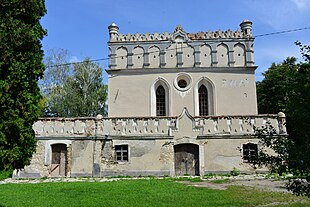| Great Synagogue | |
|---|---|
 The former synagogue, in 2018 | |
| Religion | |
| Affiliation | Orthodox Judaism (former) |
| Rite |
|
| Ecclesiastical or organisational status |
|
| Status | Abandoned |
| Location | |
| Location | Heroiv Maidanu Street, Husiatyn, Ternopil Oblast 48200 |
| Country | Ukraine |
Location of the former synagogue in Ukraine | |
| Geographic coordinates | 49°04′24″N 26°12′31″E / 49.07333°N 26.20861°E |
| Architecture | |
| Type | Synagogue architecture |
| Style |
|
| Completed |
|
The Great Synagogue (Festungs-Schule) is a former Orthodox Jewish synagogue, located on Heroiv Maidanu Street, in Husiatyn, Ternopil Oblast, Ukraine. The congregation worshipped initially in the Ashkenazi rite;[1] however, by the late 19th-century, the congregation worshipped according to Hassidic practices.[2]
Described as "one of the loveliest and most splendid in Galicia",[3] and as "exquisite",[4] the former synagogue building is listed as a monument of Architectural Heritage of National Importance of Ukraine.
History[edit]
Built in the Polish–Lithuanian Commonwealth in 1654,[a] the synagogue is a rare example of Renaissance fortress architecture.[4][10][11] After a fire in 1742, the synagogue was rebuilt and almost lost all its distinctive defensive features. The rebuild incorporated Moorish Revival and Gothic Revival decorative elements in the façade and interior.
Damaged during and after World War II the building ceased to operate as a synagogue following invasion by German Nazis in 1941.[2] In 1972 the standing ruin was renovated and turned into a Jewish history museum.[12] In 2014, the building, no longer a museum, was listed by government authorities as available for lease.[6] Today,[when?] the roof has collapsed and the building stands vacant.
See also[edit]
Notes[edit]
References[edit]
- ^ "Great Synagogue in Husiatyn, Ukraine". The Bezalel Narkiss Index of Jewish Art. Israel: Center for Jewish Art. n.d. Retrieved 30 March 2024.
- ^ a b "Husiatyn". History of Jewish Communities in Ukraine. 28 May 2013. Retrieved 30 March 2024.
- ^ Ansky, S. (2003). The Enemy at His Pleasure: A Journey Through the Jewish Pale of Settlement During World War I. Translated by Joachim Neugroschel. Macmillan. p. 253.
- ^ a b Bartov, Omer (2007). Erased: Vanishing Traces of Jewish Galicia in Present-day Ukraine. Princeton University Press. p. 105 ff.
- ^ "Husiatyn. A view of the 16th century fortress synagogue" (image and text). YIVO Archives: Jewish life in Poland. The University of Illinois at Urbana-Champaign. 2011. Retrieved 30 March 2024.
- ^ a b "Deteriorating Husiatyn, Ukraine fortress synagogue is for rent". Jewish Heritage Europe. 26 November 2014. Retrieved 4 October 2019.
- ^ "Great Synagogue (Husiatyn)". Religiana. Belgium. 2024. Retrieved 30 March 2024.
- ^ Wilkinson, Chris (21 May 2016). "The Last Place In the World – Husiatyn, Ukraine: Lost In Time". LinkedIn. Retrieved 30 March 2024.
- ^ Seitz, Abby (2024). "Synagogues of Ukraine, Past and Present". My Jewish Learning. Retrieved 30 March 2024.
- ^ "Pds Sso". Digital.cjh.org. Archived from the original on 19 February 2020. Retrieved 3 March 2014.
- ^ "Ukraine synagogues part 1". Jewish postcards.
- ^ "Synagogye". Judaica.kiev.ua. Archived from the original on 11 February 2012. Retrieved 3 March 2014.
External links[edit]
- 1920 Archived 2020-02-19 at the Wayback Machine[dead link]
- "Image of the synagogue". Flickr. 2007.

Well, that’s interesting to know that Psilotum nudum are known as whisk ferns. Psilotum nudum is the commoner species of the two. While the P. flaccidum is a rare species and is found in the tropical islands. Both the species are usually epiphytic in habit and grow upon tree ferns. These species may also be terrestrial and grow in humus or in the crevices of the rocks.
View the detailed Guide of Psilotum nudum: Detailed Study Of Psilotum Nudum (Whisk Fern), Classification, Anatomy, Reproduction